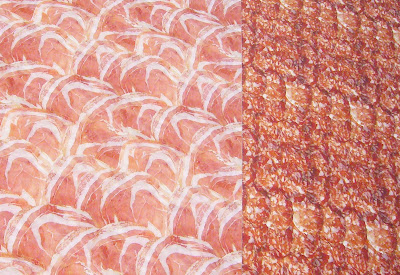a friday farm tour

Guess where I was 2 weeks ago? If you guessed 'Kashmir', you would be incorrect. I was actually a mere 15 minute drive from my house at A.C. Gilmore Farms (above), located on No. 8 Road in Richmond, B.C. (The llama’s name is ‘Ben’ and that’s the Nanaksar Gurdwara Guru Sikh Temple in the background.) I was out farm touring with my friend’s Arlene Kroeker (columnist for the Richmond Review) and Anne Casselman (creator and writer for Food and Tell)..... 3 women, 3 farms, in 3 hours.
Founded 3 generations ago by Andy Capp Gilmore, this 236 acre spread is now run by A.C. Gilmore & Sons Company. In turn, a four acre portion of the property is being rented by Gilmore grandson, Andy, and his wife, Dee. In her previous life before moving to the farm, Dee was the owner and operator of ‘Crazy Horse Live Stock & Pet Food Supply’. Full of energy, vision and enthusiasm, she was a most informative and entertaining hostess as she toured us around the land and the barns, showing us their various pets and livestock, all while filling us in on some of the local agricultural gossip..... there is enough material there to create a Dallas-esque t.v. series, I swear. Horses, sheep, llamas, goats, dogs, turkeys (who happened to be listening to country music on the barn radio when we dropped by) and chickens seem to all coexist well, though the dogs are not allowed near anything with wings, for they are sure to eat it. A self-described ‘meatatarian’, Dee does grow some fruit and vegetables close to their house, but usually gives most of it away, instead preferring a steady diet of meat and poultry..... with the exception of potatoes and the occasional squash. Because she raises her organic chickens for a duration of 63 days vs. the usual 23, the birds are allowed to mature long enough that their bones can calcify and produce gelatin (and flavour!) when cooked. At $5/ lb, these tasty beauties are a delicious bargain. The 6 pounder I bought is currently sitting pretty in my freezer, waiting patiently to become the perfect Sunday dinner. To buy chicken from Dee, email her @ crzhorse@telus.net


Making new friends at Gilmore Farms.
Next, we dropped in on Tai On Farms. Helen and her sister, who is known to everyone as 'Auntie', have owned and operated for an impressive 35 years. Originally the first in the Richmond area to grow Chinese produce, today they continue to sell their beautiful, fresh fruit and vegetables direct to the public from their retail location on No. 5 Rd.
Last, but certainly not least, we paid a return visit to Jose @ JPS Vegetable Farm. I had been to see him a few times last Spring, always enjoying his warmth, his extensive botanical knowledge and, most of all, his childlike enthusiasm. Since last May there have been a few additions; most notably, a cow named Susie. In turn, she has independently aquired 2 goat friends of her own. Though they actually live across the street, they walk themselves over to JPS each morning, enjoy a full day of grazing with their bovine buddy, and then return home each night before dark.

Susie and the kids at JPS Vegetable Farm. If you drop by Jose's you can purchase his fresh eggs and produce, or just wander through the quirky, enchanted greenhouse / doggy day care. JPS Vegetable Farm is located at 12700 Blundell Rd in Richmond.





















